Here's an overview:
- Introduction to Tutankhamun and Ancient Egyptian History
- The Life and Reign of Tutankhamun
- The Discovery of Tutankhamun's Tomb
- The Treasures of Tutankhamun's Tomb
- Tutankhamun's Curse: Fact or Fiction?
- The Legacy of Tutankhamun and His Impact on Ancient Egyptian History
- The Religious and Cultural Beliefs of Ancient Egypt
- The Role of Pharaohs in Ancient Egypt
- Daily Life in Ancient Egypt
- Unraveling the Mysteries of Ancient Egyptian Hieroglyphs
Introduction to Tutankhamun and Ancient Egyptian History
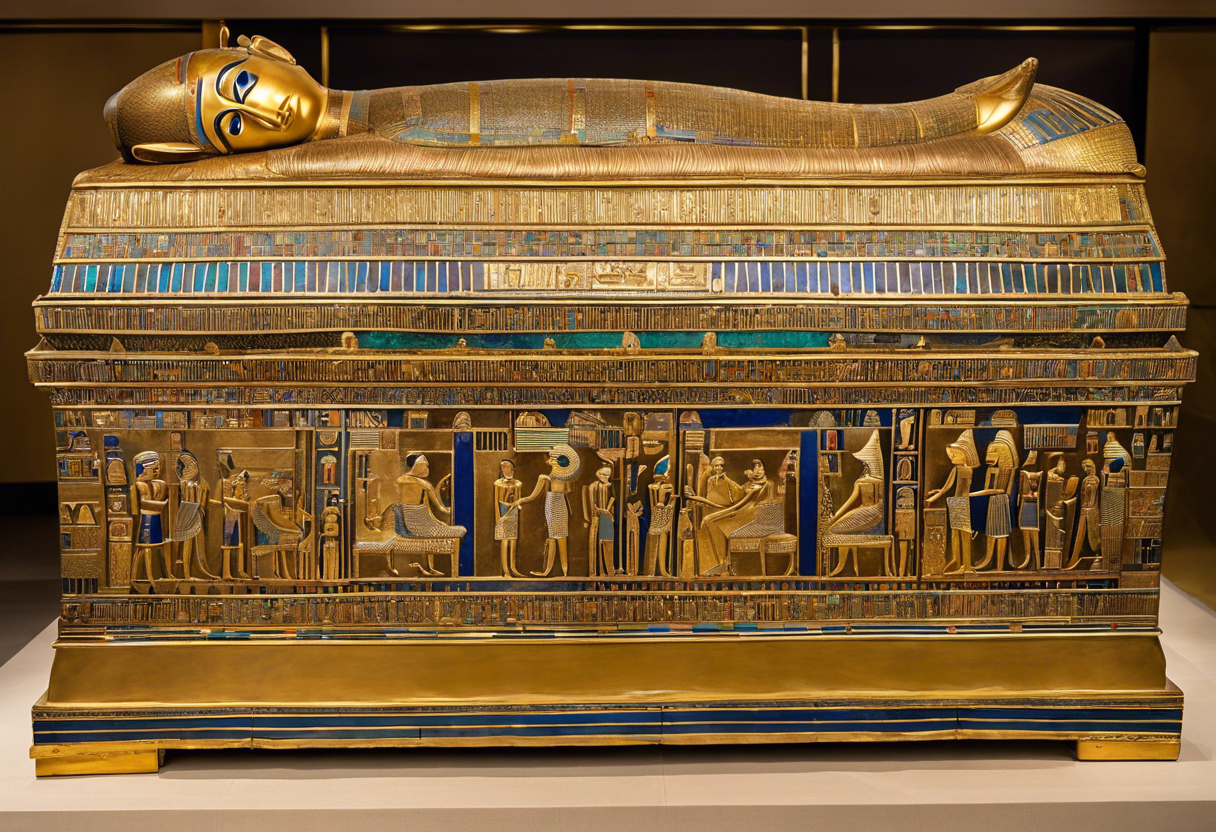
The discovery of the tomb of Tutankhamun in 1922 by British archaeologist Howard Carter captivated the world and shed new light on the ancient Egyptian civilization. This section will provide an introduction to Tutankhamun and give an overview of ancient Egyptian history, setting the stage for the exploration of this legendary tomb.
Ancient Egypt, one of the oldest and most fascinating civilizations in history, flourished along the banks of the Nile River for thousands of years. Its culture, religious beliefs, art, and architectural achievements have left an indelible mark on human history. From the architectural wonders of the pyramids and temples to the detailed artistry and hieroglyphic writings, ancient Egypt continues to captivate our imagination.
Tutankhamun, also known as the "Boy King," was an Egyptian pharaoh who reigned from around 1332 to 1323 BCE during the period known as the New Kingdom. He ascended to the throne at a young age and died unexpectedly around the age of 18 or 19. What made Tutankhamun particularly fascinating was the discovery of his nearly intact tomb in the Valley of the Kings in Luxor, Egypt.
The tomb of Tutankhamun, designated as KV62, contained a vast array of artifacts and treasures, including his famous golden funerary mask. The rich burial goods found in his tomb provided valuable insights into the religion, art, craftsmanship, and daily life of the ancient Egyptians. The meticulous preservation of the tomb revealed the intricate burial rituals and beliefs surrounding the afterlife.
To understand Tutankhamun's significance, it is important to have a broader understanding of ancient Egyptian history. The civilization developed around 3100 BCE and endured for over 3,000 years until its conquest by Alexander the Great in 332 BCE. Ancient Egyptian history is often divided into periods, including the Predynastic, Old Kingdom, Middle Kingdom, New Kingdom, and Late Period.
During the Old Kingdom, the pyramids were constructed as tombs for the pharaohs, symbolizing their divine power and eternal life. The Middle Kingdom marked a period of cultural and political stability, while the New Kingdom saw the rise of powerful pharaohs like Hatshepsut, Thutmose III, and Amenhotep III.
The religious beliefs of ancient Egyptians centered around polytheism, with numerous gods and goddesses worshipped for different aspects of life. The pharaoh was seen as the intermediary between the gods and the people, responsible for maintaining cosmic order and ensuring the prosperity of the kingdom.
Understanding ancient Egyptian history helps us appreciate Tutankhamun's place in the grand narrative of this remarkable civilization. The exploration of his tomb allowed scholars and archaeologists to uncover valuable insights into the complexities of the ancient Egyptian world, offering a glimpse into the lives of both the ruling elite and the common people.
In the following sections, we will delve deeper into the discovery of Tutankhamun's tomb and explore the wonders and mysteries it revealed.
The Life and Reign of Tutankhamun

Tutankhamun, also known as the "Boy King," was an ancient Egyptian pharaoh who reigned during the 14th century BCE, from approximately 1332 BCE to 1323 BCE. Despite the brevity of his reign, which lasted only around nine years, Tutankhamun holds a significant place in Egyptian history and continues to captivate the imagination of people around the world.
Tutankhamun ascended to the throne at the young age of nine or ten, following the death of his father, Akhenaten. He was the son of Akhenaten and one of his secondary wives, possibly Kiya. The circumstances surrounding his rise to power are still shrouded in mystery, and much debate remains amongst historians. Initially, Tutankhamun's reign was heavily influenced by the regents who ruled on his behalf, namely Ay and Horemheb.
During his early years as pharaoh, Tutankhamun initiated the restoration of the traditional Egyptian religious practices, which had been disrupted by his father's monotheistic religious reforms. He abandoned the capital city of Akhetaten, built by Akhenaten, and moved the seat of power back to Thebes, reinstating the worship of Amun-Ra as the chief deity.
One of Tutankhamun's notable achievements was his dedication to the restoration and construction of various temples and religious shrines throughout Egypt. Many of these structures had fallen into disrepair during his father's reign, and Tutankhamun sought to restore the religious balance and rejuvenate the economy by investing in these projects.
Although Tutankhamun's reign was relatively short, it is believed that he had a close association with powerful individuals such as the general Horemheb and the high priest of Amun, Ay. Some scholars suggest that these individuals may have influenced his decisions and policies during his rule.
Tutankhamun's death in 1323 BCE, at the age of around nineteen or twenty, marked the end of his reign. The cause of his death remains uncertain, although modern scientific examination of his mummified remains has indicated that he may have suffered from a combination of physical ailments, including a broken leg, malaria, and complications from a foot infection.
After his death, Tutankhamun was buried in a lavish tomb in the Valley of the Kings, near Luxor. This tomb, designated as KV62, remained undiscovered for over 3,000 years until its stunning excavation by British archaeologist Howard Carter in 1922.
Despite the relatively short duration of his reign, Tutankhamun's tomb has left an indelible mark on history due to its remarkable preservation and the wealth of artifacts and treasures it contained. The discovery of the tomb provided a wealth of insight into the opulence and religious beliefs of ancient Egypt, making Tutankhamun one of the most famous and studied pharaohs to date.
The Discovery of Tutankhamun's Tomb
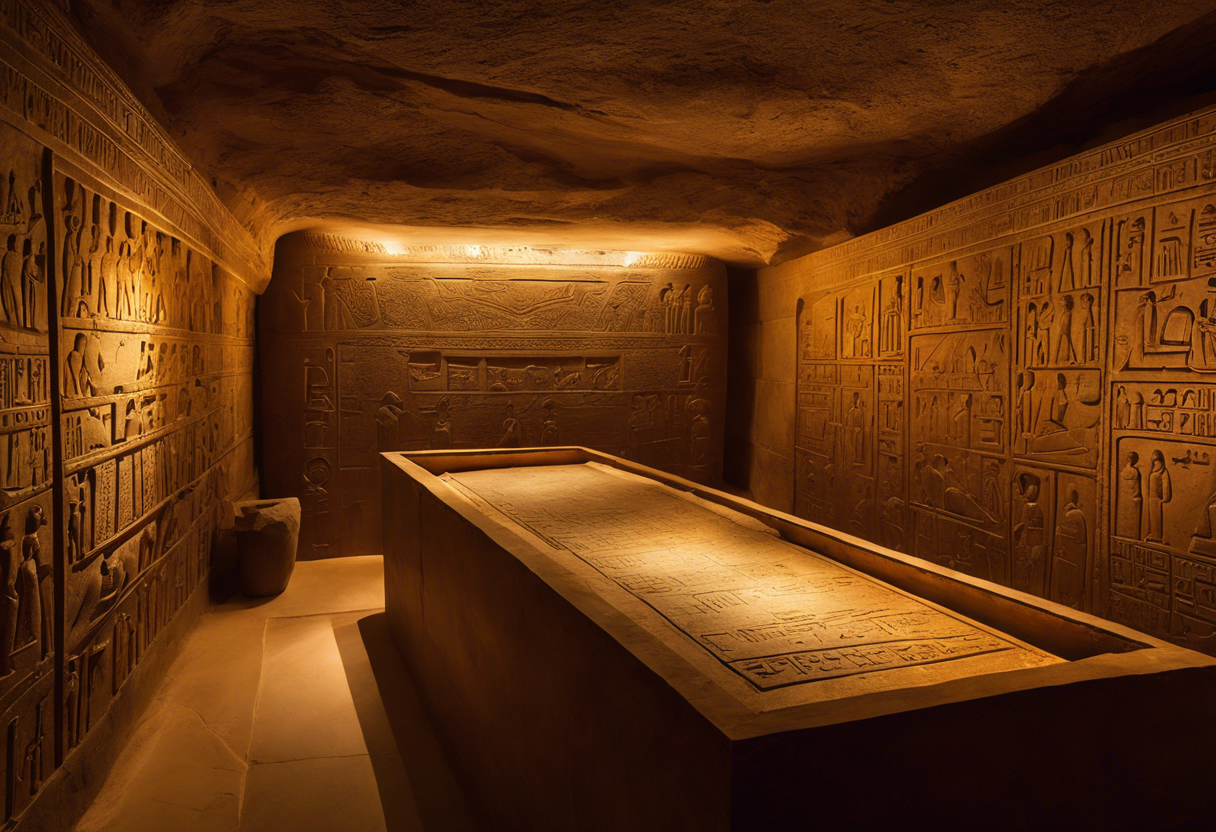
In November 1922, a team of archaeologists led by British Egyptologist Howard Carter made one of the most significant discoveries in the history of archaeology: the tomb of Tutankhamun. Located in the Valley of the Kings in Egypt, this remarkable find would forever change our understanding of ancient Egyptian civilization.
Carter had been conducting excavations in the Valley of the Kings for years, hoping to uncover the burial site of the boy Pharaoh, Tutankhamun, who reigned during the 14th century BCE. He had faced numerous setbacks and disappointments, but his persistence and unwavering belief in the existence and significance of the tomb kept him going.
Finally, in November 1922, Carter's patience paid off. While excavating the area near the tomb of another pharaoh, he stumbled upon the top of a flight of steps leading into the ground. As he descended into the darkness, the unmistakable scent of ancient decay filled the air. This was it—the long-awaited entrance to Tutankhamun's burial chamber.
What Carter and his team uncovered inside the tomb was nothing short of extraordinary. The tomb had remained largely undisturbed for over 3,000 years, protecting a wealth of precious artifacts and offering a unique glimpse into the life and death of a pharaoh. From intricately carved golden masks and jewelry to elaborately decorated chariots and statues, the tomb was filled with treasures beyond imagination.
The most famous find in Tutankhamun's tomb was undoubtedly the golden funerary mask that covered the Pharaoh's mummified face. This iconic image has become synonymous with ancient Egypt and has come to symbolize the wealth and power of its rulers. The intricate craftsmanship and attention to detail showcased in the mask are a testament to the skilled artisans of the time.
Carter and his team carefully cataloged and removed each artifact from the tomb, documenting its position and significance. This meticulous approach ensured that the tomb would remain intact for future study and preservation. The excavation and subsequent analysis of Tutankhamun's tomb greatly enriched our understanding of ancient Egyptian art, religion, and burial practices.
The discovery of Tutankhamun's tomb was a turning point in the world of archaeology. It sparked widespread fascination with ancient Egypt and laid the foundation for further exploration and research. The treasures unearthed from the tomb continue to captivate and inspire millions of people around the world, shedding light on the lives of the ancient Egyptian elite and their beliefs about the afterlife.
In conclusion, the discovery of Tutankhamun's tomb by Howard Carter and his team in 1922 was a momentous event in the field of archaeology. The untouched riches found inside provided an unprecedented look into the majestic world of the ancient Egyptians and the life of a pharaoh. This remarkable find forever changed our understanding of ancient Egypt and continues to captivate the imagination of people today.
The Treasures of Tutankhamun's Tomb
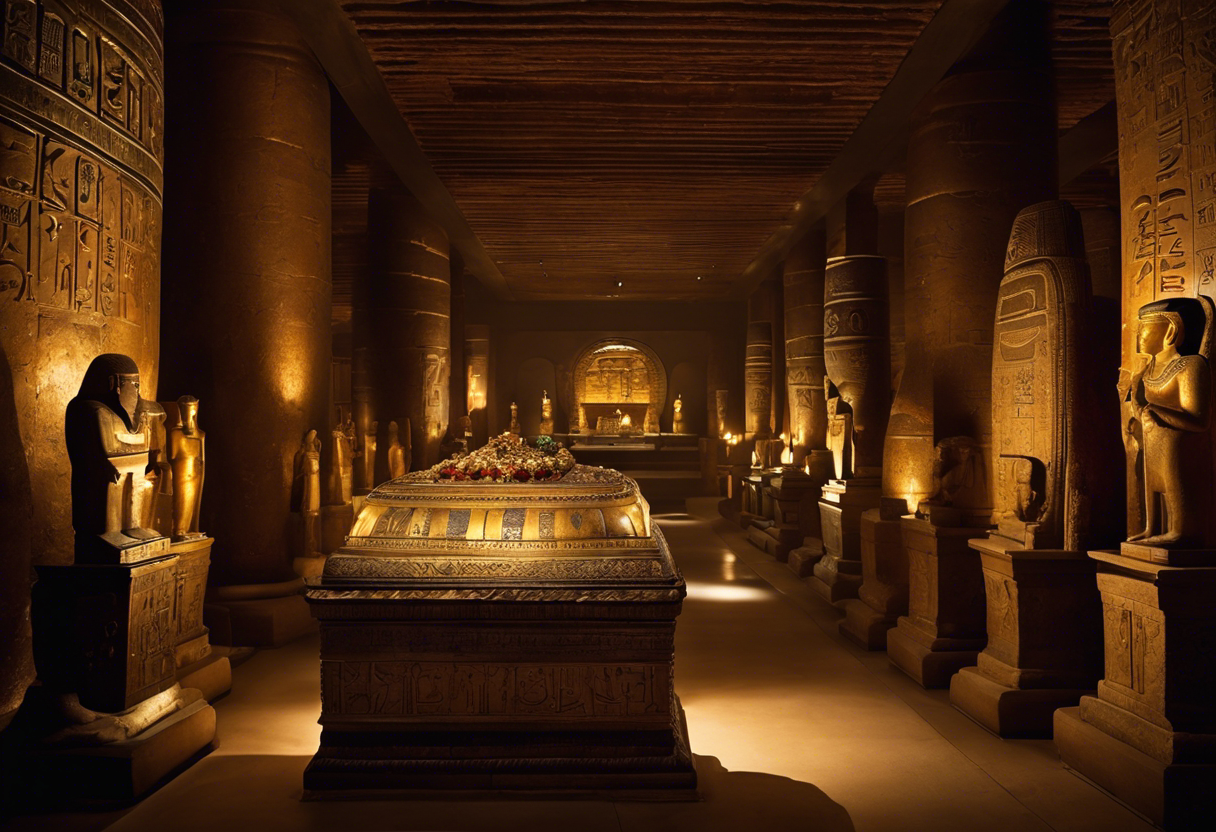
When Howard Carter first entered the tomb of Tutankhamun in 1922, he couldn't have imagined the incredible treasures that awaited within. The tomb, though small in size, was packed with an astonishing array of artifacts, providing a glimpse into the opulence and grandeur of ancient Egyptian civilization.
One of the most striking discoveries in the tomb were the golden funerary masks. The most famous of these masks is the one that covered the face of King Tutankhamun himself. It is a masterpiece of artistry and craftsmanship, made entirely of solid gold. The mask not only served as a protective covering for the mummy but also represented the king's eternal divine nature.
The tomb also contained a wealth of extravagant jewelry. Countless necklaces, bracelets, rings, and pendants were found, adorned with precious gemstones such as lapis lazuli and turquoise. These exquisite pieces not only highlight the expertise of ancient Egyptian jewelers but also provide insights into the significance of jewelry as symbols of power and wealth in their society.
Another fascinating find in Tutankhamun's tomb was an assortment of chariots and boats. These objects were meant to accompany the pharaoh in the afterlife, allowing him to travel and engage in activities just as he did in life. The intricate details on these miniature vehicles and vessels give us a glimpse into the ancient Egyptian's advanced knowledge of engineering and craftsmanship.
The tomb also yielded a remarkable collection of furniture and household items. Elaborate chairs, beds, and chests were discovered, beautifully decorated with intricate carvings and precious materials. These furnishings provide valuable insights into the daily life and rituals of the ancient Egyptians, offering a rare glimpse into their domestic environments.
In addition to these physical treasures, the tomb also contained a multitude of religious and ceremonial artifacts. Exquisite statues, amulets, and ritual objects were discovered, each with its own specific purpose and significance within ancient Egyptian religious beliefs. These artifacts not only shed light on the spiritual practices and rituals of the time but also underline the importance of religious beliefs in Egyptian society.
The treasures found in Tutankhamun's tomb have not only captivated the world but have also significantly expanded our knowledge of ancient Egypt. These artifacts continue to be studied and admired for their beauty, historical significance, and the precious insights they provide into the life and times of one of Egypt's most enigmatic rulers. Through these treasures, we have been granted a precious window into a civilization that thrived thousands of years ago.
Tutankhamun's Curse: Fact or Fiction?
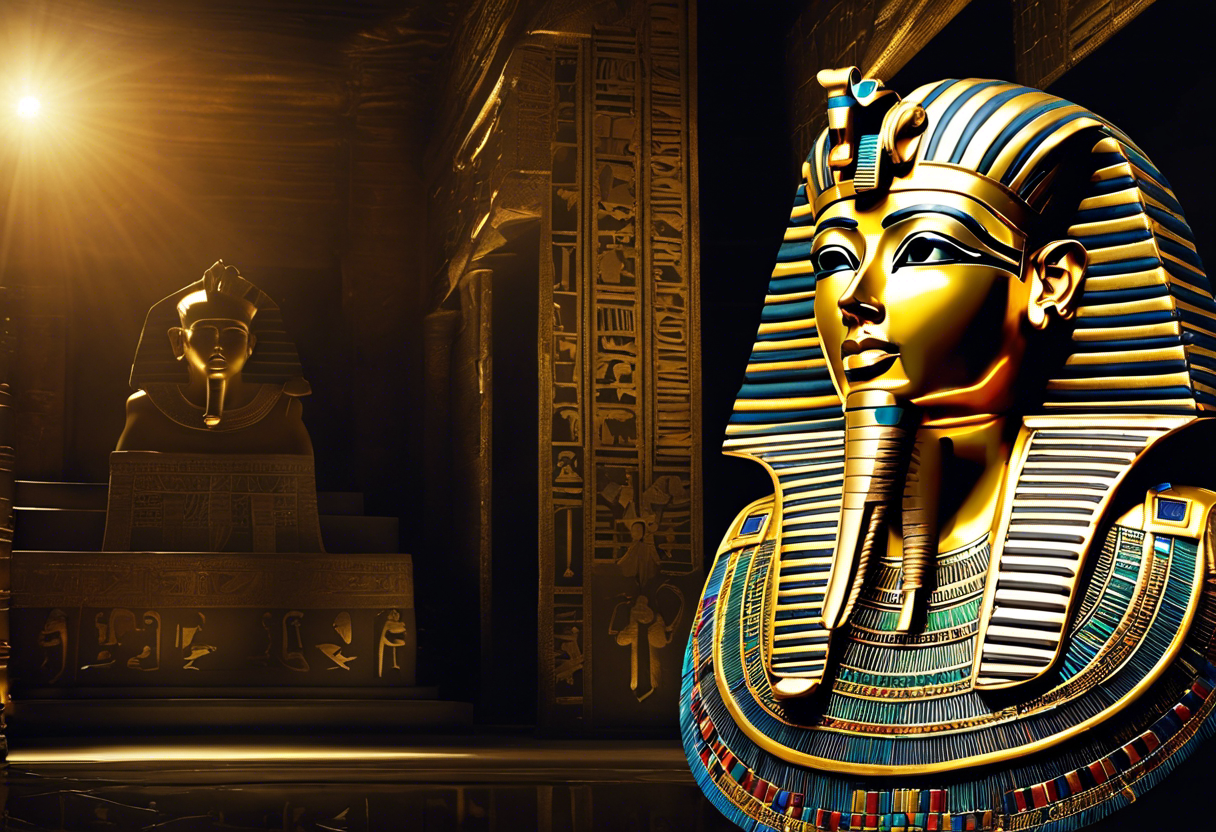
The discovery of the tomb of Tutankhamun in 1922 by British archaeologist Howard Carter captivated the world and gave rise to a popular belief in the existence of a curse associated with the pharaoh's tomb. This supposed curse, often referred to as "Tutankhamun's Curse," has been the subject of fascination and debate for many years. But is it based on fact or mere fiction?
- The Origins of the Curse
The idea of a curse associated with Tutankhamun's tomb emerged shortly after its discovery. The theory gained traction due to the mysterious and untimely deaths of several individuals connected to the excavation. Lord Carnarvon, the financial backer of the expedition, died shortly after the tomb was opened, leading many to attribute his death to the curse.
- Scientific Explanations
While the notion of a curse may seem compelling, scientific explanations dismiss the idea. The untimely deaths can be attributed to a combination of factors such as exposure to infectious diseases and accidents. Historical records show that individuals who visited the tomb did not immediately suffer any ill effects, further weakening the curse theory.
- Statistics and Coincidences
Skeptics argue that the number of deaths associated with Tutankhamun's tomb does not exceed what would be expected by chance alone. The law of large numbers suggests that with thousands of people involved in the excavation and the subsequent examination of the artifacts, it is statistically likely that a few deaths would occur within a given timeframe.
- Media Hype and Public Imagination
The curse of Tutankhamun became a sensationalized topic, capturing the attention of the media and public imagination. This amplified the belief in the curse, creating a myth that persisted even though scientific evidence refutes its existence. The allure and mystery surrounding ancient Egyptian culture made it an ideal subject for speculative and sensationalized storytelling.
While the notion of Tutankhamun's Curse continues to captivate the imagination, archaeological and scientific evidence provides a rational explanation for the alleged curse. The deaths associated with the tomb can be attributed to natural causes rather than a supernatural curse. It is important to approach such legends and myths with a critical mindset, relying on scientific inquiry and evidence-based reasoning to separate fact from fiction.
By examining the facts and dispelling myths, we gain a deeper understanding of the fascinating archaeological discovery that is the tomb of Tutankhamun.
The Legacy of Tutankhamun and His Impact on Ancient Egyptian History

Tutankhamun, the boy pharaoh, may have had a short reign during the 14th century BCE, but his legacy has left a profound impact on ancient Egyptian history. The discovery of his intact tomb in the Valley of the Kings in 1922 by British archaeologist Howard Carter has revealed a wealth of information about the royal burial practices, religious beliefs, and artistic styles of the time. This section explores the enduring legacy of Tutankhamun and how his tomb has shaped our understanding of ancient Egypt.
1. Preserving the Past: Intact Burial and Artifacts
One of the significant aspects of Tutankhamun's tomb is that it was found largely undisturbed and filled with a vast array of burial items. The treasures found within the tomb provide invaluable insights into the art, craftsmanship, and daily life of the ancient Egyptians. The intricate golden death mask, jewelry, furniture, and chariots highlight the artistic skill and craftsmanship of the period. These artifacts have been meticulously documented, preserved, and studied, contributing to our knowledge of ancient Egyptian society.
2. Understanding Ancient Egyptian Beliefs
Tutankhamun's tomb also shed light on the religious beliefs and rituals practiced in ancient Egypt. The elaborate funerary rituals, intricate tomb decorations, and the presence of canopic jars containing the pharaoh's organs reflect the Egyptians' belief in the afterlife and their efforts to ensure immortality. The presence of hieroglyphic inscriptions and symbolic depictions within the tomb have helped scholars decipher the complex religious practices and beliefs of the time.
3. Impact on Archaeology and Egyptology
The discovery of Tutankhamun's tomb and the subsequent excavation captivated the world, sparking a renewed interest in ancient Egyptian history and archaeology. The treasure-filled tomb was a significant turning point in the field of Egyptology, providing a wealth of artifacts and information for scholars to study. Countless books, documentaries, and exhibitions have been dedicated to Tutankhamun, fueling public fascination with the ancient world.
4. Cultural and Economic Impact
The legacy of Tutankhamun has extended beyond the realm of archaeology. The treasures and artifacts from his tomb have traveled the world, drawing millions of visitors and generating substantial revenue for the Egyptian tourism industry. The cultural impact of the boy king's tomb cannot be overstated, as it has inspired countless works of art, literature, and films, further immortalizing Tutankhamun and ancient Egypt in popular culture.
In conclusion, Tutankhamun's tomb has left an indelible mark on ancient Egyptian history. His intact burial and the wealth of artifacts found within have deepened our understanding of ancient Egyptian society, religious beliefs, and artistic achievements. The discovery of his tomb has also had a lasting impact on the field of Egyptology, inspiring further research and public interest. The cultural and economic significance of Tutankhamun's legacy continues to resonate worldwide, ensuring that the name of the boy king lives on in the annals of history.
The Religious and Cultural Beliefs of Ancient Egypt
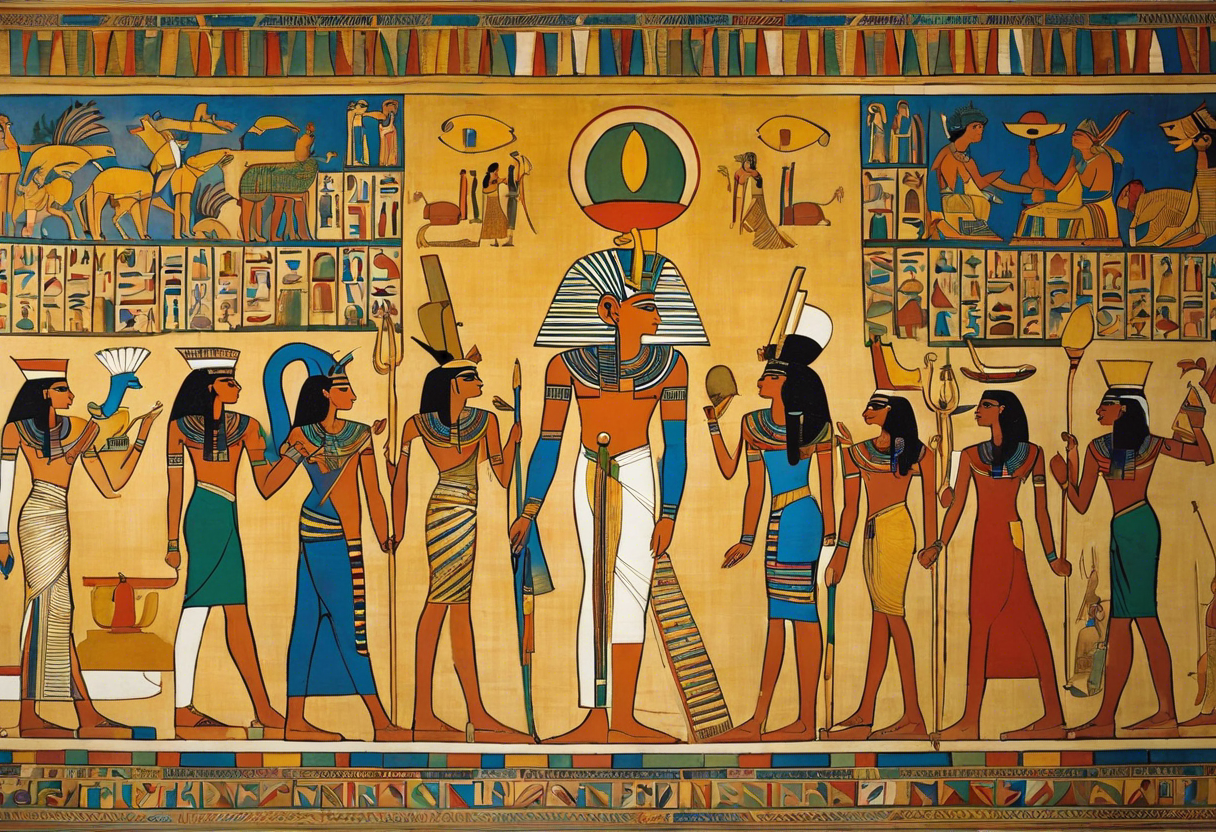
Religion played a central role in the lives of the ancient Egyptians, permeating every aspect of their society. Their beliefs and practices shaped their daily lives and influenced their interactions with the natural world and the afterlife.
Polytheistic Worship
The ancient Egyptians were polytheistic, believing in the existence of a multitude of deities. They worshipped gods and goddesses who represented various natural elements, celestial bodies, and abstract concepts. Each deity had a distinct personality, role, and sphere of influence. The most prominent gods were Ra, the sun god; Osiris, the god of the afterlife; and Isis, the goddess of fertility and magic. The gods were often depicted in human or animal forms and were believed to possess immense powers and abilities.
Pharaoh as a Divine Figure
The pharaoh held a special place in ancient Egyptian society, being considered a divine being and the intermediary between the gods and the people. The pharaoh was believed to have received his power and authority directly from the gods, and it was his responsibility to maintain harmony between the gods and the people. The rituals and ceremonies performed by the pharaoh, such as offering sacrifices and leading religious festivals, were believed to appease the gods and ensure the well-being of the kingdom.
Rituals and Offerings
Religious rituals were an essential part of ancient Egyptian life, performed in temples and homes. These rituals involved prayers, hymns, and offerings to the gods. Egyptians believed that the gods required sustenance, so offerings of food, drink, and incense were made to ensure their favor. The priests played a crucial role in performing these rituals and maintaining the temples. They were seen as the intermediaries between the gods and the people, and their duties included conducting ceremonies, interpreting omens, and preserving religious texts.
The Importance of the Afterlife
The ancient Egyptians believed in the existence of an afterlife, where the deceased would continue their existence in a new form. They believed that the soul, or ka, needed the body to survive in the afterlife. To ensure the preservation of the body, elaborate burial practices were carried out. These included mummification, the process of preserving the body by removing the internal organs and treating the body with various substances. Funerary rituals and ceremonies were also performed to assist the deceased in their journey to the afterlife.
Cultural Impact
The religious beliefs of ancient Egypt had a profound impact on every aspect of their culture. Their beliefs in an afterlife and the importance of preserving the body led to the development of complex burial practices and the construction of magnificent tombs. The emphasis on divine authority and the pharaoh's role as a mediator between gods and people shaped the political and social structure of ancient Egypt. The gods and goddesses were not just objects of worship but integrated into everyday life, believed to influence natural phenomena and provide protection and blessings.
In conclusion, religion was an integral part of ancient Egyptian society, influencing their beliefs, rituals, and cultural practices. The polytheistic worship, the divinity of the pharaoh, the significance of rituals and offerings, and the belief in an afterlife all played vital roles in shaping the religious and cultural beliefs of this fascinating civilization.
The Role of Pharaohs in Ancient Egypt
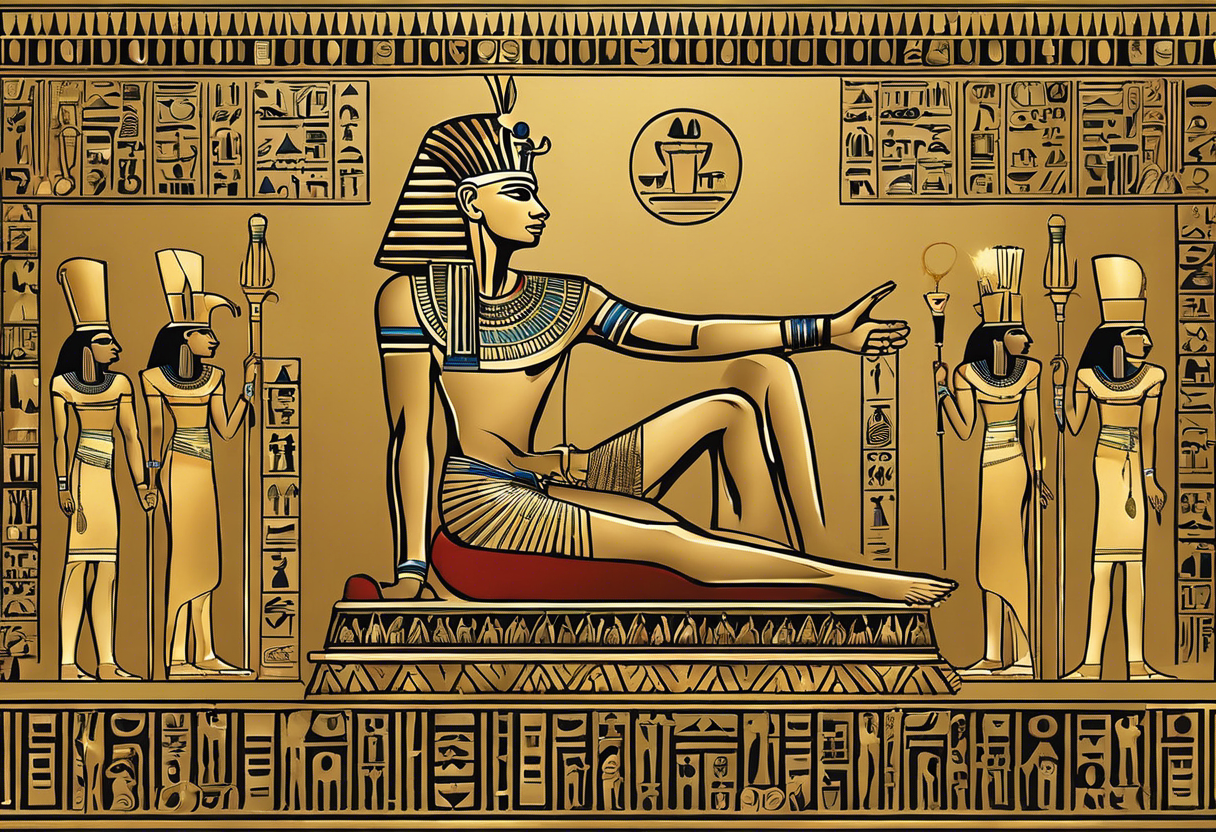
The pharaohs held a position of supreme power and authority in ancient Egypt. They were not only considered political leaders but were also seen as divine figures, believed to be the intermediaries between the gods and the people. Understanding the role of pharaohs is crucial to unraveling the mysteries of ancient Egyptian society.
The Pharaoh as a Ruler
Pharaohs were the absolute rulers of Egypt and held complete control over the land, its resources, and its people. They were responsible for maintaining order, enforcing laws, and leading the military. Pharaohs were seen as the embodiment of Ma'at, the concept of cosmic balance and harmony. By upholding Ma'at, they ensured the stability and prosperity of their kingdom.
The Pharaoh as a Religious Figure
In addition to their political power, pharaohs played a significant role in the religious beliefs of ancient Egypt. They were considered divine beings, believed to be descended from the gods themselves. Pharaohs were seen as the earthly representation of particular deities, such as Horus or Amun-Ra. This divine status was further reinforced through elaborate rituals and ceremonies.
Pharaohs were responsible for maintaining a strong connection between the earthly realm and the world of the gods. They were believed to possess special powers and had the ability to communicate with the deities. Through their religious duties, Pharaohs performed important rituals to ensure the prosperity and protection of Egypt.
The Pharaoh and the Afterlife
The belief in the afterlife was central to Egyptian culture, and the role of the pharaoh in the journey to the afterlife was crucial. Pharaohs were believed to be the link between the mortal world and the realm of the gods. It was believed that upon their death, pharaohs would ascend to the heavens and rule alongside the gods for eternity.
To prepare for their journey to the afterlife, pharaohs constructed grand tombs and burial sites, such as the famous pyramids. These tombs were filled with treasures and possessions that the pharaoh would need in the afterlife. The process of mummification was also performed to ensure the preservation of the pharaoh's body.
The role of the pharaoh in the afterlife extended beyond their personal journey. They were responsible for the well-being and protection of their subjects even after death. The pharaohs were seen as guardians of the people, ensuring their prosperity and safety both in this life and the next.
Pharaohs and their Legacy
The influence of pharaohs extended far beyond their lifetimes. The reign of a pharaoh left a lasting impact on the culture, architecture, and beliefs of ancient Egypt. Each pharaoh added their own contributions to the kingdom, leaving behind a legacy that was often remembered and celebrated for centuries.
The pharaohs were also responsible for commissioning grand monuments and temples to honor the gods and perpetuate their own memory. These structures, such as the temples of Luxor and Karnak, serve as a testament to the power and influence of the pharaohs in ancient Egyptian society.
In conclusion, the pharaohs held a unique and powerful role in ancient Egypt. They were not only political rulers but also religious figures. Their influence extended to the afterlife, where they were believed to rule alongside the gods. The legacy of the pharaohs can still be seen in the magnificent structures they built and the impact they had on the culture of ancient Egypt.
Daily Life in Ancient Egypt
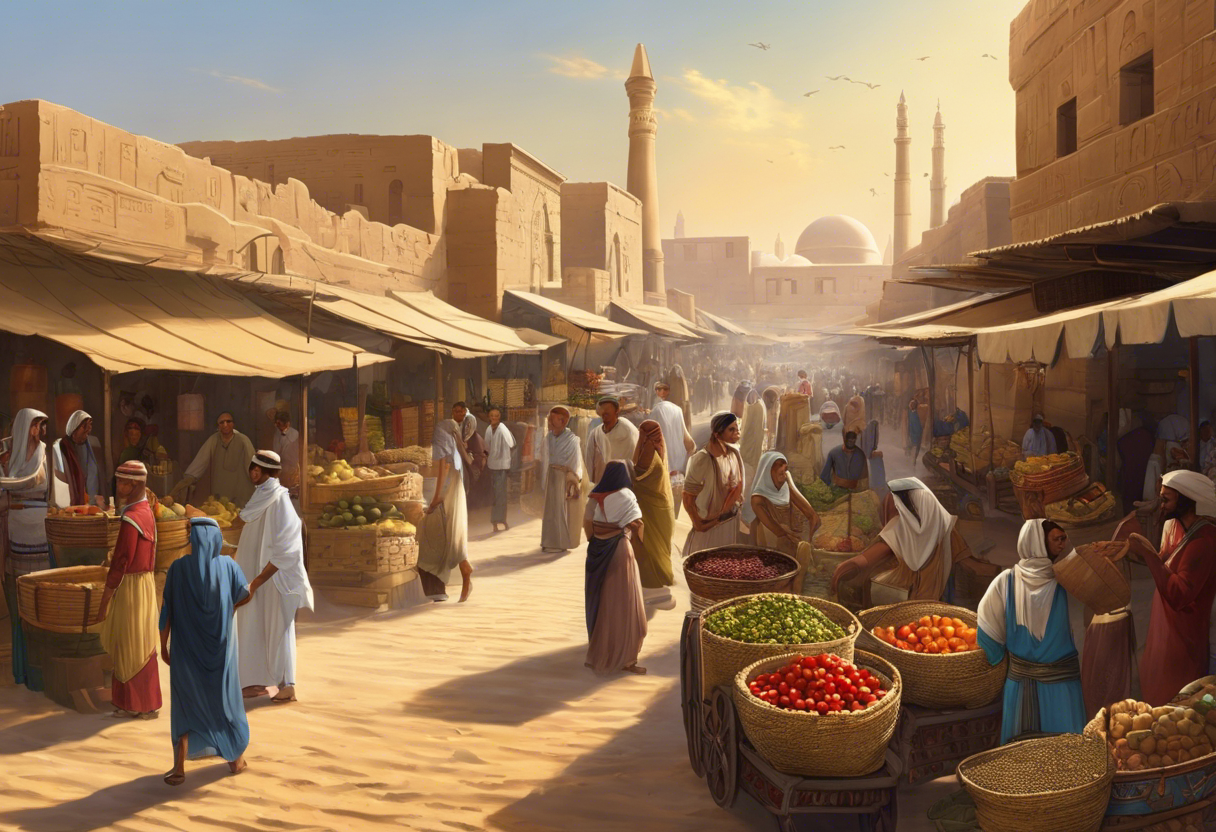
Ancient Egypt was a civilization that flourished for thousands of years along the banks of the Nile River. The daily life of the people in this ancient civilization was deeply influenced by their beliefs, customs, and social hierarchy.
Social Hierarchy
In Ancient Egypt, society was organized in a hierarchical structure, with the pharaoh at the top. The pharaoh, who was considered a divine ruler, held ultimate power and authority. Below the pharaoh were the nobles, priests, and scribes, who played important roles in maintaining the administration and religion of the kingdom.
Next in the social hierarchy were the craftsmen, merchants, and farmers who formed the middle class. They were the backbone of the economy and played vital roles in the daily life of Ancient Egyptians. At the bottom of the societal pyramid were the manual laborers and slaves who worked in various professions.
Family Life
Family was a central aspect of daily life in Ancient Egypt. The nuclear family, consisting of a husband, wife, and their children, was the basic unit of society. Marriage was considered sacred, and Egyptian couples were expected to have children to ensure the continuation of their family line.
Women held significant roles within the family structure. While men held more prominent positions in society, women had the rights to own property, accumulate wealth, and even divorce their husbands. They were also involved in various professions and could work outside the home.
Education and Learning
Education in Ancient Egypt was primarily reserved for the elite classes, particularly the sons of the nobles and priests. These privileged individuals were sent to special schools, where they were taught reading, writing, mathematics, and religious teachings. The aim of education was to prepare them for administrative or religious roles.
Daily Activities
Ancient Egyptians were engaged in a range of daily activities. Agriculture was the backbone of their economy, and farmers worked the fertile lands along the Nile River. They grew crops such as barley, wheat, and flax, which were used for food and to produce linen, a fabric highly valued in ancient times.
Art and craftsmanship were highly esteemed in Ancient Egypt. Skilled artisans created exquisite sculptures, jewelry, pottery, and detailed wall paintings. Architecture also played a significant role in daily life, with grand temples, tombs, and monuments being constructed throughout the kingdom.
Religion was an integral part of daily life, and Egyptians worshipped a pantheon of gods and goddesses. Temples were sacred spaces where people could offer prayers, make offerings, and seek divine intervention. Festivals and rituals were held regularly to honor these deities.
Conclusion
The daily life of Ancient Egyptians was characterized by a strong social hierarchy, a deep sense of family, a focus on education, and engagement in various activities such as agriculture, art, and religious practices. Exploring the tomb of Tutankhamun offers a unique glimpse into the material culture and artifacts that shaped the daily lives of these ancient people.
Unraveling the Mysteries of Ancient Egyptian Hieroglyphs
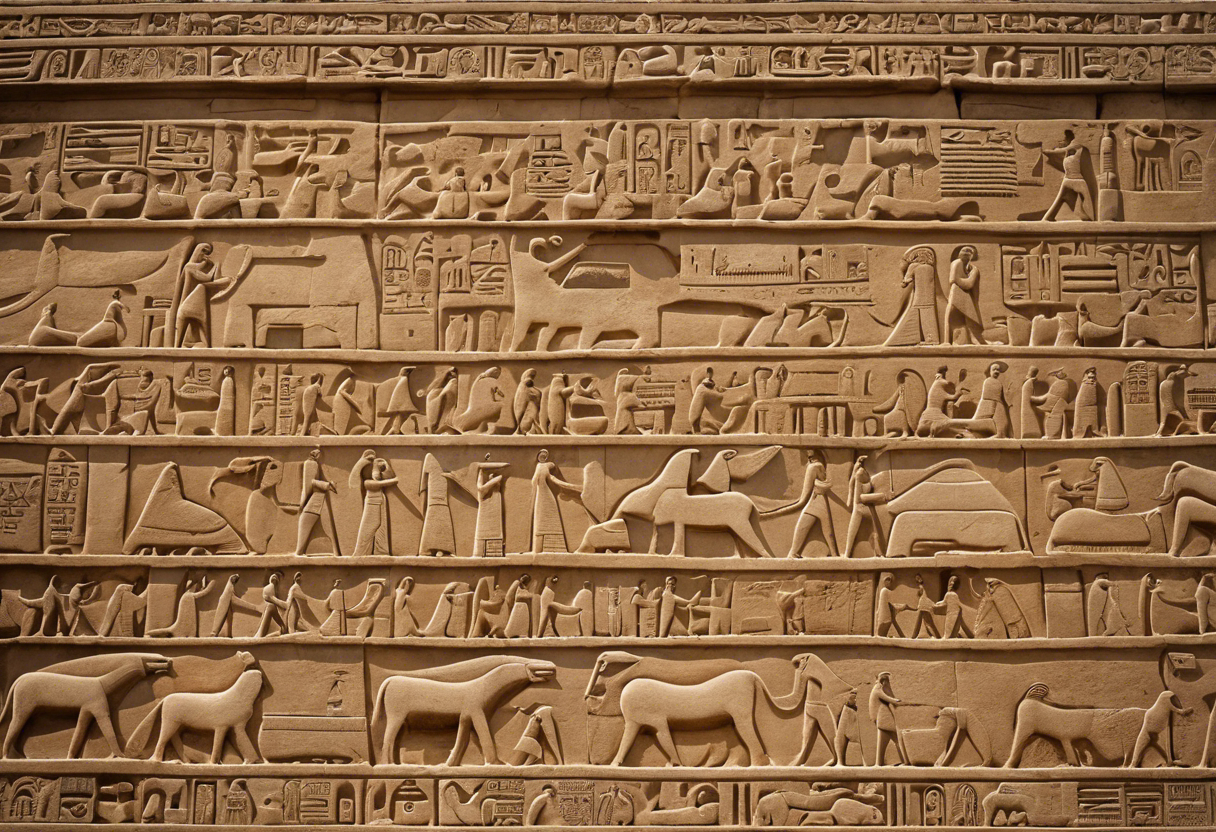
Hieroglyphs, the ancient Egyptian writing system, have long fascinated archaeologists and historians. These intricate symbols were the means through which the ancient Egyptians communicated, recorded events, and preserved their knowledge. Deciphering hieroglyphs has been a complex puzzle that took centuries to solve, but advancements in Egyptology have helped us unravel their mysteries.
Ancient Egyptian hieroglyphs were first discovered in the late 18th century, but it wasn't until the early 19th century that progress in deciphering them began. One of the most significant breakthroughs came with the discovery of the Rosetta Stone in 1799, which contained inscriptions in three scripts: hieroglyphic, demotic, and Greek. The stone provided a key to understand hieroglyphs since the Greek text served as a guide for translation.
Using the Rosetta Stone as a starting point, French scholar Jean-François Champollion successfully deciphered the hieroglyphic script in 1822. He compared the Greek text to the hieroglyphic symbols, identifying common words and phrases. This breakthrough marked a pivotal moment in Egyptology, as it opened the door to understanding the complex world of ancient Egypt.
Hieroglyphs consist of a combination of images, phonetic signs, and determinatives. The images represented objects and concepts, while the phonetic signs represented sounds. Determinatives, on the other hand, provided clues about the meaning of a word by categorizing it. Understanding the intricate relationship between these elements was crucial in deciphering hieroglyphs.
The decipherment of hieroglyphs revealed a wealth of knowledge about ancient Egyptian civilization. It allowed historians to read inscriptions on temple walls, decipher royal tombs, and understand texts that portrayed daily life, religious rituals, and historical events. The ancient Egyptian language came to life through the decipherment of hieroglyphs, providing a unique window into their culture and beliefs.
Modern Egyptologists have built upon the work of early pioneers and continue to unlock the secrets hidden within hieroglyphs. New discoveries and advancements in technology have facilitated the translation of more complex texts, shedding light on previously inaccessible aspects of ancient Egypt's history.
In conclusion, unraveling the mysteries of ancient Egyptian hieroglyphs has been a fascinating journey that has transformed our understanding of this ancient civilization. The decipherment of hieroglyphs, initiated by Champollion and carried forward by modern Egyptologists, has allowed us to delve deeper into the rich culture, traditions, and history of the ancient Egyptians. As new insights continue to emerge, we can only anticipate the further unfolding of the secrets concealed within these captivating symbols.
